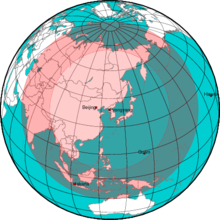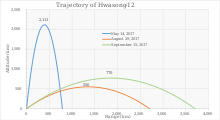Hwasong-12
| Hwasong-12 | |
|---|---|
 | |
| Type | Ballistic missile, Mobile IRBM/ICBM |
| Place of origin | North Korea |
| Service history | |
| In service | Successful test on 14 May 2017 |
| Used by | Korean People's Army Strategic Force |
| Production history | |
| Manufacturer | North Korea |
| Produced | June 2017 |
| Specifications | |
| Mass | 24.7 tons (est.) |
| Height | 16.5 m (est.) |
| Diameter | 1.5 m (est) |
| Warhead |
|
| Warhead weight | 500-650 kg (est.) |
| Engine |
Liquid-propellant rocket, single chamber variant of Paektusan 464.1 kN total |
| Propellant |
Hypergolic combination of unsymmetrical dimethylhydrazine (UDMH) as fuel, and either Dinitrogen tetroxide (N 2O 4) |
Operational range |
3,700–6,000 km (est.) |
| Flight altitude | 2,111.5 km at lofted trajectory (which reduces range to 787 km) |
Guidance system |
Inertial |
| Accuracy | greater than 5 km CEP |
Launch platform |
MAZ-based vehicle |
| Korean name | |
| Chosŏn'gŭl | 《화성-12》형 |
|---|---|
| Hancha | 火星十二型 |
| Revised Romanization | Hwaseong-12 |
| McCune–Reischauer | Hwasŏng-12 |
The Hwasong-12 (Korean: 《화성-12》형 or 《화성포-12》형; Hanja: 火星 12型; lit. Mars Type 12; KN-17 under the U.S. naming convention) is a mobile intermediate-range ballistic missile developed by North Korea. The Hwasong-12 was first revealed to the international community in a military parade on 14 April 2017 celebrating the Day of the Sun which is the birthday anniversary of North Korea's founding President, Kim Il Sung. North Korea tested Hwasong-12 on 30 January 2022.
Design

Based on photos of the launch on 14 May 2017, the Hwasong-12 appears to be a single stage design, using a single main engine along with four vernier engines. The arrangement appears similar to the "high-thrust" engine test conducted in March 2017. Alternatively, it could be based on the engine used in the older Hwasong-10 with the addition of two more verniers.
Initial estimates suggest the Hwasong-12 would have a maximum range of between 3,700 kilometres (2,300 mi) with a 650 kg (1,430 lb) payload and 4,500 km (2,800 mi) with a 500 kg (1,100 lb) payload, to as much as 6,000 km (3728 mi) (ICBM means a range of at least 5,500 km). In the April 2017 military parade the Hwasong-12 was displayed on the Hwasong-10 mobile launcher, and it may be intended to replace the similarly performing Hwasong-10 which has been shown unreliable during its test program.
Hwasong-8
On the morning of 27 September 2021, a Hwasong-8 missile was launched in Ryongrim County, although it was reportedly fitted with a manoeuvrable reentry vehicle, which would achieve hypersonic speed. Ankit Panda, a senior fellow at the Carnegie Endowment for International Peace, stated that the new missile looked like the booster of Hwasong-12 upon inspection of the sole image of the missile, but more images would be needed to confirm it. This was one of the five 'most important' weapons laid out in a five year plan in the 8th Congress of the Workers' Party of Korea, where the development of the missile was reported to have already been completed. State media of North Korea described it as a weapon of great strategic significance.
The missile apparently flew on a depressed trajectory, reaching an apogee of 30 km and a range of 200 km, although it is likely that a part of the missile's path would have been untraceable with radar due to its ability to manoeuvre. The test reportedly confirmed its navigational control and stability, as well as the guiding manoeuvrability and flight characteristics of the detached hypersonic gliding warhead. However, the missile allegedly failed to actually achieve hypersonic flight, with South Korean intelligence determining it only reached Mach 2.5-3, whereas hypersonic weapons are considered to travel at a speed of at least Mach 5 (1.7 km/s; 6,100 km/h) although actual data on the flight was not publicly released. The South Korea Joint Chiefs of Staff (JCS) assessed that the Hwasong-8 was at an early stage of development and would take a "considerable period of time" until it could be deployed in combat. North Korea also stated that the missile was launched through "ampulization," where the liquid fuel is sealed in the launch canister. This allows the fuel to be stored for years and eliminates the need to conduct fueling before launch, reducing preparation time needed before firing, although the JCS still claimed a 'significant amount of time' was needed to deploy the missile.
List of Hwasong-12 tests


①: Taepodong-1 ②: Unha-2 ③: Unha-3 ④: Kwangmyŏngsŏng (Unha-3) ⑤: Hwasong-12 ⑥: Hwasong-12
| Attempt | Date | Location | Pre-launch announcement / detection | Outcome | Additional notes |
|---|---|---|---|---|---|
| 1 | 4 April 2017 06:12 a.m. Pyongyang Standard Time | Sinpo | None | Failure | Previously misreported as a SCUD variant. Missile traveled a range of 60 kilometers with an apogee of 189 kilometers and reportedly "pinwheeled" before flight was terminated. |
| 2 | 15 April 2017 05:51 a.m. Pyongyang Standard Time | Sinpo | None | Failure | Previously misreported as a SCUD variant. Reported to have exploded within 4, 5 seconds after launch. |
| 3 | 28 April 2017 05:33 a.m. Pyongyang Standard Time |
Pukchang 39.5076°N 125.9645°E / 39.5076; 125.9645 |
None | Failure | Missile reportedly flew 40 kilometers before exploding. |
| 4 | 14 May 2017 04:58 a.m. Pyongyang Standard Time | Kusong | None | Success | Missile was fired on a lofted trajectory with apogee of 2,111.5 km, landing 787 km away in the Sea of Korea. |
| 5 | 29 August 2017 05:28 a.m. Pyongyang Standard Time | Sunan | None | Success | Missile was fired on a normal trajectory with apogee of 550 km, flew over Hokkaido in total distance of 2,700 km, landed in the Pacific Ocean 1,180 km east of the northern Japanese island. |
| 6 | 15 September 2017 06:27 a.m. Pyongyang Standard Time | Sunan | None | Success | Missile was fired on a normal trajectory with apogee of 770 km, flew over Hokkaido in total distance of 3,700 km, landed in the Pacific Ocean 2,200 km east of Cape Erimo, Hokkaido. Longest trajectory by a North Korean missile as of launch date. |
| 7 | 30 January 2022 07:52 a.m. Pyongyang Standard Time | Jagang | None | Success | Missile was fired on a lofted trajectory with apogee of 2,000 km, landing 800 km away in the Sea of Korea. |
| 8 | 4 October 2022 07:23 a.m. Pyongyang Standard Time | Jagang | None | Success | Missile was launched, reaching an apogee of 970 km and landing 4500 km away in the Pacific Ocean, east of Japan.
Photos showed the missile with a different engine configuration and thrust-vector control system, differently shaped and possibly shorter nosecone or reentry vehicle, and possibly slightly longer second stage, so it is unknown if the test was of a "new-type" IRBM or modified Hwasong-12. This version demonstrated the ability to deliver an almost 20% greater payload than previous Hwasong-12 missiles. |
Technical specifications
